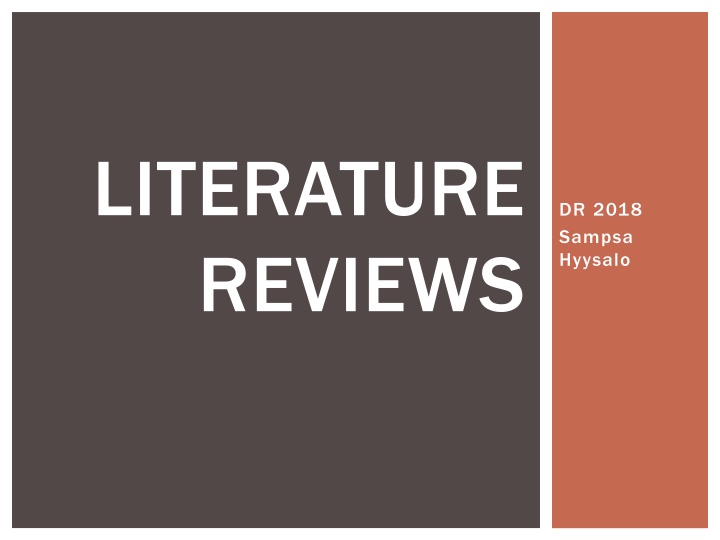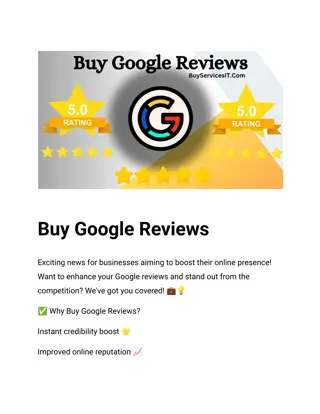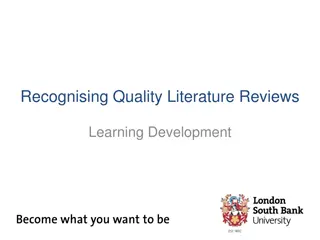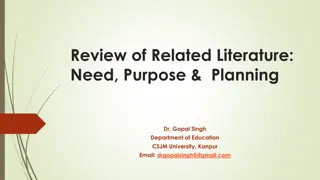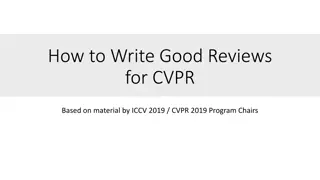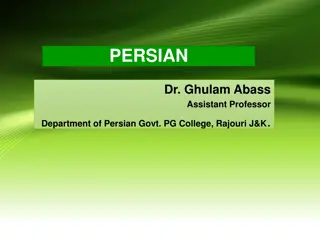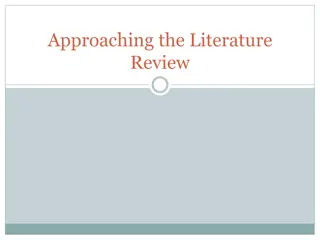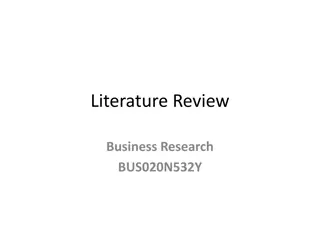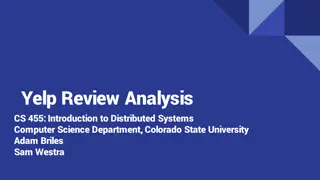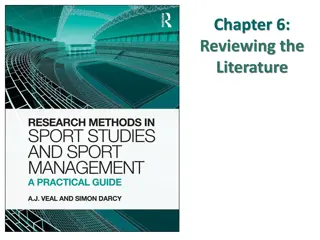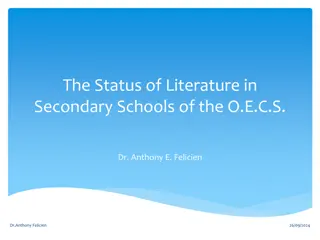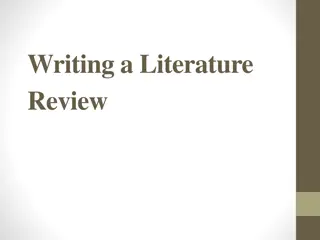LITERATURE REVIEWS
This content provides an overview of various types of literature reviews including formal, integrative, and interpretive reviews. It explains the characteristics and purposes of each type, offering insights into how literature reviews can be conducted in academic research.
Download Presentation

Please find below an Image/Link to download the presentation.
The content on the website is provided AS IS for your information and personal use only. It may not be sold, licensed, or shared on other websites without obtaining consent from the author.If you encounter any issues during the download, it is possible that the publisher has removed the file from their server.
You are allowed to download the files provided on this website for personal or commercial use, subject to the condition that they are used lawfully. All files are the property of their respective owners.
The content on the website is provided AS IS for your information and personal use only. It may not be sold, licensed, or shared on other websites without obtaining consent from the author.
E N D
Presentation Transcript
LITERATURE REVIEWS DR 2018 Sampsa Hyysalo
TYPES OF ARTICLES: AN OVERVIEW
MOST COMMON TYPES OF ARTICLE FAMILIES Statistical analyses on naturally occurring phenomena/data Theoretical articles Process / change reports Comparative studies Literature reviews / Meta-analyses Experiment reports Construction reports Experience reports / Reflections Interpretative critique papers
TYPES OF LITERATURE REVIEWS: FORMAL Systematic literature review Pre-set and defined terms and phenomena Defined domain area and criteria for it Defined criteria for what counts as relevant research and what of it is included Requires a well known research phenomenon e.g. IT implementation success and success factors May include hypotheses that are then validated /falsified Journal based literature review What do particular field of researchers think or do in regards to topic x Orlikowski & Iacono: Desperately Seeking the "IT" in IT Research A Call to Theorizing the IT Artifact. MIS Quartely, 2001. Overview / educational literature review Often educational vademecum writing that represents research on a topic within a field: can be and often ends up highly perspectival in the eyes of other experts
TYPES OF LITERATURE REVIEWS: INTEGRATIVE Integrative literature review Defines a phenomenon and integrates research bearing on it (same extension / referent) from different literatures E.g. Williams & Edge: Soscial shaping of technology. 1996. Research policy. Rogers, E: Diffusion of Innovation. 1963/1995 Engestr m: DRW looking back and into the zone of proximal development. Nordisk pedagogic 1996. More interpretative, more omissions: domain and review terms often far more loosely defined More purposive in regards to what is relevant and what is not (both what research is included and what is included of the research reports, e.g. theories can be discarded and just findings integrated) Can and often does include field organizing i.e. pointing out State of research streams (mature, emerging, waning, branching) Gaps Future or emerging research directions
TYPES OF LITERATURE REVIEWS: INTERPRETIVE Re-conceptualization better structuring literature review / retheorizing Takes previous research and gives it alternative/improved theoretical explanation or structure Often takes the form of pointing to a neglected but arguably central or important phenomenon that should be in included Can be a whole sale lit review OR review different positions of different authors AND/OR empirical evidence that backs these positions or the domain as a whole Overview / positional literature review Often part of empirical work: positions the phenomena and finds gap(s) / limits to which the rest of the work then contributes new knowledge Uneven: skips over lightly well known parts to the overall fields to concentrate on themes most relevant for the study / concern at hand Purposive: builds an argument why the present / further research is meaningful
PRECURSOR TO LIT REVIEW ORGANIZATION To assess To choose How many refs are there to review How uniform is the material How much intricacy is in the material How different is the material (visual, film, text, artifacts built) How large a terrain What is the knowledge interest What can you expect readers to know already Do fields or disciplines or approaches matter Organization of the lit review Sources reviewed Principles of the lit review Sensible mode of organization Sub modes of organization if needing more complex structure
PIECE BY PIECE / APPROACH BY APPROACH Discuss each work at the time Pro/con Simple technically Good starting point Hard to compare refs in multiple dimensions (and keep readable) - Hard to follow: needs flow of argument and intermittent summaries - Hard for comparison; comparison needs to be done differently - Synthesis or topicalization typically an add-on - Limit to number of pieces that can be reviewed ( lumping or clustering strategies options) String of ref reviews Preserves the contribution, aim, field and orientation differences etc. Used when discussing in- depth; e.g. developing a theoretical framework Allows using original terms and concepts Often used in discussing theories or other long exposition requiring topics
TOPICAL Pro/Con Organize rev into key topics Refs discussed only insofar related to a topic The topic set derived from literature (Dominant themes? Emerging themes? Practice/policy concern?) Typically max 3-7 themes/topics Each ref is typically discussed in (half) a sentence, max two paragraphs Typical in distilling key findings related to an area of interest, showing which pieces contribute to findings. One ref can be discussed from several angles Allows mixing one-topic-only and multi-topic pieces fairly Allows showing scarcity in some topics Allows different registers for different topics (often necessary) Allows mixing journals - Refs easily reduced to just few isolated contributions - Juggle / mix needed to keep visible differences in - Journals - Importance of contribution - Field / school differences
JOURNAL BY JOURNAL / DISCIPLINE BY DISCIPLINE Organize rev journal by journal / discipline Pro/con Helps render visible journal / discipline differences Shows complementarity or field lacunae Can discuss different disciplines partially in their own terms - Topics can get lost (may require a table or different chapter) - Specificities and complex arguments easily lost - Different disciplines can become hijacked to synthetic or some discipline s framing of the topic Requires 1-3 fairly clear topics shared by journals / fields Definitional work needed: different terms and interrelations needed Discuss what each field has Paid attention to How plentifully By what kind of research/methods/data What they ve found Where they might be going Within field often topical organization needed Often: argue for multidiscplinarity or cover very broad terrains; contours of 5 refs to a sentence
CASCADE Deploy piece/topic/jounal cascading Pro/con Allows first discussing nuances duly Still deploys the sense of key topics or cross cutting themes / fields Can be cascaded further to practice / strategy / policy - Can become long and baroque - The following cascades unlikely to retain full force as they tend to be shorter derivatives Begin with piece by piece coverage to discuss in depth Deploy topicalisation (as somewhat shorter) Deploy field review (as table et cetera) Deploy
SUBMIX Pro/con Category/subcategory mix Use primary categorization e.g. topic Use secondary categorization e.g. journal within each topic any use of tertiary categorization needs to be very clear (e.g. research type: conceptual, hypothesis, empirical, experimental, qualitative, quantitative) Good in gaining two dimensional lit review (often desired) - With many different logics the text can become very hard and technical to follow
SECTIONED Clearly different sections Pro/con Lit review is separated into one compartment Two different sets of review are kept separate; one paves the way to the other Different empirics get different lit reviews Multiple data papers and books Helps shift gears or perspective - If many sections, gets overly complex for articles
IN SUM To assess To choose How many refs are there to review How uniform is the material How much intricacy is in the material How different is the material (visual, film, text, artifacts built) How large a terrain What is the knowledge interest What can you expect readers to know already Do fields or disciplines or approaches matter Organization of the lit review Sources reviewed Principles of the lit review Sensible mode of organization Sub modes of organization if needing more complex structure
